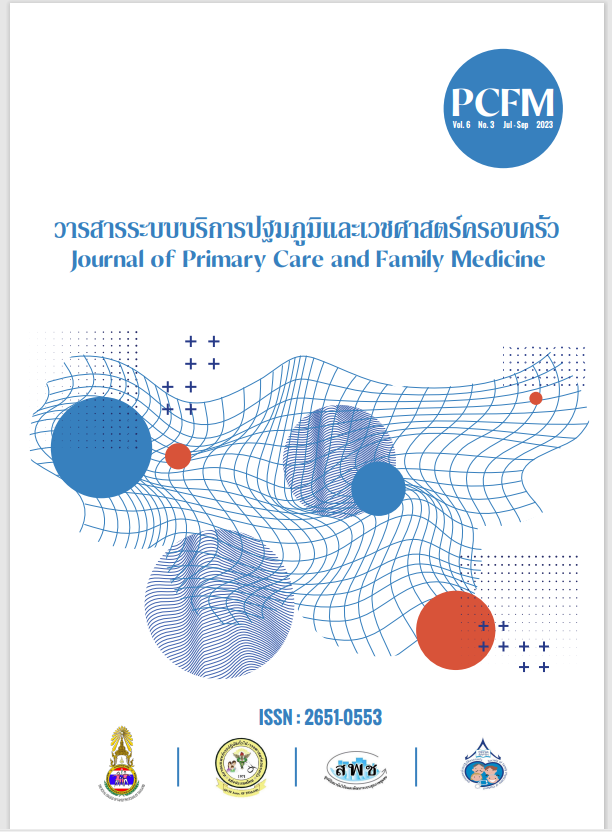อัตราการจ่ายยาและปัจจัยที่เกี่ยวข้องกับการตัดสินใจจ่ายยา benzodiazepine ในผู้สูงอายุของแพทย์ที่ปฏิบัติงานในโรงพยาบาลราชวิถี
Main Article Content
บทคัดย่อ
ที่มาและวัตถุประสงค์: ปัจจุบันมีคำแนะนำให้หลีกเลี่ยงการใช้ยา benzodiazepine ในผู้สูงอายุเนื่องจากผลเสียเช่น เพิ่มความเสี่ยงโรคความจำเสื่อม เพิ่มอัตราการล้มและบาดเจ็บซึ่งอาจต้องรักษาตัวในโรงพยาบาลหรือรุนแรงถึงขั้นเสียชีวิต ผู้วิจัยจึงต้องการศึกษาการอัตราการตัดสินใจจ่ายยาและปัจจัยที่เกี่ยวข้องกับการตัดสินใจจ่ายยา benzodiazepine ในผู้สูงอายุของแพทย์ที่ปฏิบัติงานในโรงพยาบาลตติยภูมิ
วิธีการศึกษา: การศึกษาแบบภาคตัดขวาง เก็บข้อมูลช่วงเดือนมกราคมถึงมิถุนายน พ.ศ. 2564 แบบสอบถามประกอบด้วยข้อมูลส่วนตัว การตัดสินใจจ่ายยา benzodiazepine ในผู้สูงอายุ 5 กลุ่มโรค การจ่ายยาเกินความจำเป็นและแหล่งอ้างอิงที่ใช้ประกอบในการจ่ายยา ใช้สถิติเชิงพรรณนา Chi-square test และ Fishers’ exact test
ผลการศึกษา: ผู้เข้าร่วมวิจัยมีทั้งหมด 92 คน อายุเฉลี่ย 29±5.5 ปี ส่วนใหญ่เป็นแพทย์ประจำบ้านร้อยละ 87 ชั่วโมงการทำงานเฉลี่ย 40 ชั่วโมงต่อสัปดาห์ จากแบบสอบถามพบว่าอัตราการตัดสินใจจ่ายยา benzodiazepine แพทย์ทั่วไปร้อยละ 66.3 จ่ายยานี้ให้แก่ผู้สูงอายุที่มีภาวะวิตกกังวล พบปัจจัยที่แตกต่างกันอย่างมีนัยสำคัญระหว่างกลุ่มตัดสินใจจ่ายยาและไม่จ่ายยาในผู้สูงอายุที่เป็นความดันโลหิตสูง คือ ชั่วโมงในการทำงาน (ต่อสัปดาห์) (p = 0.01)
สรุปผล: อัตราการจ่ายยา benzodiazepine ในผู้สูงอายุที่มีภาวะวิตกกังวลสูงถึงร้อยละ 66.3 จึงควรมีแนวทางอย่างง่ายให้แพทย์ทั่วไปใช้ในการพิจารณาข้อบ่งชี้ และพบว่าชั่วโมงการทำงาน (ต่อสัปดาห์) ที่สูงกว่าเป็นปัจจัยที่เกี่ยวข้องในการตัดสินใจจ่ายยา benzodiazepine ในผู้สูงอายุที่มีความดันโลหิตสูงซึ่งควรมีการศึกษาเพิ่มเติมในกลุ่มดังกล่าวต่อไป
Article Details

อนุญาตภายใต้เงื่อนไข Creative Commons Attribution-NonCommercial-NoDerivatives 4.0 International License.
เนื้อหาและข้อมูลในบทความที่ลงตีพิมพ์ในวารสาร PCFM ถือเป็นข้อคิดเห็นและความรับผิดชอบของผู้เขียนบทความโดยตรง ซึ่งกองบรรณาธิการวารสารไม่จำเป็นต้องเห็นด้วยหรือร่วมรับผิดชอบใด ๆ
บทความ ข้อมูล เนื้อหา รูปภาพ ฯลฯ ที่ได้รับการตีพิมพ์ลงในวารสาร PCFM ถือเป็นลิขสิทธิ์ของวารสาร PCFM หากบุคคลหรือหน่วยงานใดต้องการนำทั้งหมดหรือส่วนหนึ่งส่วนใดไปเผยแพร่ต่อหรือเพื่อกระทำการใด ๆ จะต้องได้รับอนุญาตเป็นลายลักษณ์อักษรจากวารสาร PCFM ก่อนเท่านั้น
เอกสารอ้างอิง
หล่อตระกูล ม. คู่มือการดูแลผู้มีปัญหาสุขภาพจิตและจิตเวชสําหรับแพทย์: กรมสุขภาพจิต; 2001.
Ashton H. Guidelines for the rational use of benzodiazepines. When and what to use. Drugs. 1994;48(1):25-40.
Panel BtAGSBCUE. American Geriatrics Society 2019 Updated AGS Beers Criteria® for Potentially Inappropriate Medication Use in Older Adults. Journal of the American Geriatrics Society. 2019;67(4):674-94.
O'Mahony D, O'Sullivan D, Byrne S, O'Connor MN, Ryan C, Gallagher P. STOPP/START criteria for potentially inappropriate prescribing in older people: version 2. Age Ageing. 2015;44(2):213-8.
Airagnes G, Pelissolo A, Lavallée M, Flament M, Limosin F. Benzodiazepine Misuse in the Elderly: Risk Factors, Consequences, and Management. Curr Psychiatry Rep. 2016;18(10):89.
Brett J, Murnion B. Management of benzodiazepine misuse and dependence. Aust Prescr. 2015;38(5):152-5.
Robinson ADT. Drag Misuse and Dependence. Guidelines on Clinical Management. Report of a Medical Working Group. London: HMSO. 1991. 58 pp. British Journal of Psychiatry. 1993;162(4):585-.
Creupelandt H, Anthierens S, Habraken H, Sirdifield C, Siriwardena AN, Christiaens T. A tailored e-learning gives long-term changes in determinants of GPs’ benzodiazepines prescribing: a pretest-posttest study with self-report assessments. Scandinavian Journal of Primary Health Care. 2019;37(4):418-25.
Sirdifield C, Anthierens S, Creupelandt H, Chipchase SY, Christiaens T, Siriwardena AN. General practitioners' experiences and perceptions of benzodiazepine prescribing: systematic review and meta-synthesis. BMC family practice. 2013;14:191-.
Vicens C, Leiva A, Bejarano F, Sempere- Verdú E, Rodríguez-Rincón RM, Fiol F, et al. Evaluation of a multicomponent intervention consisting of education and feedback to reduce benzodiazepine prescriptions by general practitioners: The BENZORED hybrid type 1 cluster randomized controlled trial. PLoS Medicine. 2022;19(5).
Luta X, Bagnoud C, Lambiris M, Decollogny A, Eggli Y, Le Pogam MA, et al. Patterns of benzodiazepine prescription among older adults in Switzerland: A cross-sectional analysis of claims data. BMJ Open. 2020;10(1).
Maust DT, Blow FC, Wiechers IR, Kales HC, Marcus SC. National Trends in Antidepressant, Benzodiazepine, and Other Sedative-Hypnotic Treatment of Older Adults in Psychiatric and Primary Care. J Clin Psychiatry. 2017;78(4):e363-e71.
Champion C, Kameg BN. Best practices in benzodiazepine prescribing and management in primary care. The Nurse Practitioner. 2021;46(3).
Agarwal SD, Landon BE. Patterns in Outpatient Benzodiazepine Prescribing in the United States. JAMA Network Open. 2019;2(1):e187399-e.
Tu K, Mamdani MM, Hux JE, Tu J-b. Progressive Trends in the Prevalence of Benzodiazepine Prescribing in Older People in Ontario, Canada. Journal of the American Geriatrics Society. 2001;49(10):1341-5.
Prueksaritanond S TS, Pumkompol T, Sukying C. . Psychotropic Drug Prescribing in the Family Medicine Out-Patient Clinic, Ramathibodi Hospital. Journal of the MEDICAL ASSOCIATION OF THAILAND. 2009;92(2):266-72.
WD. W. Biostatistics: A foundation of analysis in the health sciences. New York: John Wiley and Sons; 1995.
Bjørner T, Lærum E. Factors associated with high prescribing of benzodiazepines and minor opiates. Scandinavian Journal of Primary Health Care. 2003;21(2):115-20.
Srisurapanont M, Garner P, Critchley J, Wongpakaran N. Benzodiazepine prescribing behaviour and attitudes: a survey among general practitioners practicing in northern Thailand. BMC family practice. 2005;6:27-.
Fernández Alvarez T, Gómez Castro MJ, Baides Morente C, Martínez Fernández J. [Factors that affect the prescription of benzodiazepines and actions to improve their use: a Delphi study of primary care doctors]. Aten Primaria. 2002;30(5):297-303.


